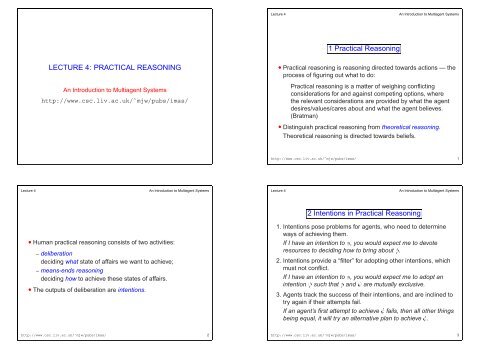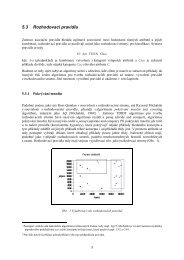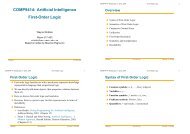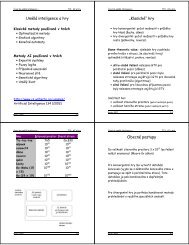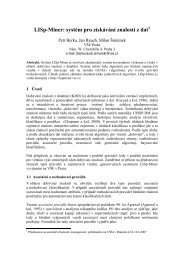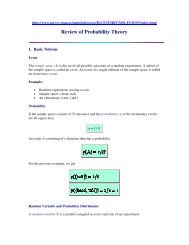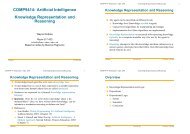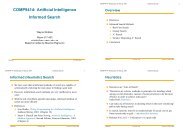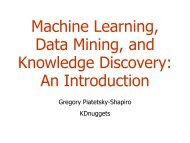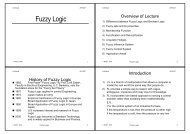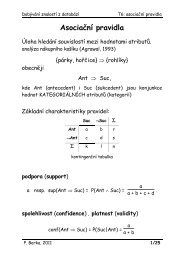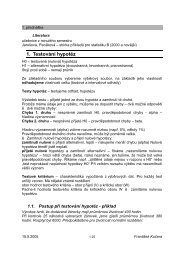LECTURE 4: PRACTICAL REASONING 1 Practical ... - Sorry
LECTURE 4: PRACTICAL REASONING 1 Practical ... - Sorry
LECTURE 4: PRACTICAL REASONING 1 Practical ... - Sorry
Create successful ePaper yourself
Turn your PDF publications into a flip-book with our unique Google optimized e-Paper software.
Lecture 4<br />
An Introduction to Multiagent Systems<br />
1 <strong>Practical</strong> Reasoning<br />
<strong>LECTURE</strong> 4: <strong>PRACTICAL</strong> <strong>REASONING</strong><br />
An Introduction to Multiagent Systems<br />
http://www.csc.liv.ac.uk/˜mjw/pubs/imas/<br />
¯<strong>Practical</strong> reasoning is reasoning directed towards actions — the<br />
process of figuring out what to do:<br />
<strong>Practical</strong> reasoning is a matter of weighing conflicting<br />
considerations for and against competing options, where<br />
the relevant considerations are provided by what the agent<br />
desires/values/cares about and what the agent believes.<br />
(Bratman)<br />
¯Distinguish practical reasoning from theoretical reasoning.<br />
Theoretical reasoning is directed towards beliefs.<br />
http://www.csc.liv.ac.uk/˜mjw/pubs/imas/ 1<br />
Lecture 4<br />
An Introduction to Multiagent Systems<br />
Lecture 4<br />
An Introduction to Multiagent Systems<br />
2 Intentions in <strong>Practical</strong> Reasoning<br />
¯Human practical reasoning consists of two activities:<br />
– deliberation<br />
deciding what state of affairs we want to achieve;<br />
– means-ends reasoning<br />
deciding how to achieve these states of affairs.<br />
¯The outputs of deliberation are intentions.<br />
1. Intentions pose problems for agents, who need to determine<br />
ways of achieving them.<br />
If I have an intention to, you would expect me to devote<br />
resources to deciding how to bring about.<br />
2. Intentions provide a “filter” for adopting other intentions, which<br />
must not conflict.<br />
If I have an intention to, you would expect me to adopt an<br />
intentionsuch thatandare mutually exclusive.<br />
3. Agents track the success of their intentions, and are inclined to<br />
try again if their attempts fail.<br />
If an agent’s first attempt to achievefails, then all other things<br />
being equal, it will try an alternative plan to achieve.<br />
http://www.csc.liv.ac.uk/˜mjw/pubs/imas/ 2<br />
http://www.csc.liv.ac.uk/˜mjw/pubs/imas/ 3
Lecture 4<br />
An Introduction to Multiagent Systems<br />
Lecture 4<br />
An Introduction to Multiagent Systems<br />
4. Agents believe their intentions are possible.<br />
That is, they believe there is at least some way that the intentions<br />
could be brought about.<br />
5. Agents do not believe they will not bring about their intentions.<br />
It would not be rational of me to adopt an intention toif I<br />
believedwas not possible.<br />
6. Under certain circumstances, agents believe they will bring about<br />
their intentions.<br />
It would not normally be rational of me to believe that I would<br />
bring my intentions about; intentions can fail. Moreover, it does<br />
not make sense that if I believeis inevitable that I would adopt<br />
it as an intention.<br />
7. Agents need not intend all the expected side effects of their<br />
intentions.<br />
If I believeµand I intend that, I do not necessarily intend<br />
also. (Intentions are not closed under implication.)<br />
This last problem is known as the side effect or package deal<br />
problem. I may believe that going to the dentist involves pain,<br />
and I may also intend to go to the dentist — but this does not<br />
imply that I intend to suffer pain!<br />
http://www.csc.liv.ac.uk/˜mjw/pubs/imas/ 4<br />
http://www.csc.liv.ac.uk/˜mjw/pubs/imas/ 5<br />
Lecture 4<br />
An Introduction to Multiagent Systems<br />
Lecture 4<br />
An Introduction to Multiagent Systems<br />
2.1 Planning agents<br />
¯Notice that intentions are much stronger than mere desires:<br />
My desire to play basketball this afternoon is merely a<br />
potential influencer of my conduct this afternoon. It must<br />
vie with my other relevant desires [. . . ] before it is settled<br />
what I will do. In contrast, once I intend to play basketball<br />
this afternoon, the matter is settled: I normally need not<br />
continue to weigh the pros and cons. When the afternoon<br />
arrives, I will normally just proceed to execute my<br />
intentions. (Bratman, 1990)<br />
¯Since the early 1970s, the AI planning community has been<br />
closely concerned with the design of artificial agents.<br />
¯Planning is essentially automatic programming: the design of a<br />
course of action that will achieve some desired goal.<br />
¯Within the symbolic AI community, it has long been assumed that<br />
some form of AI planning system will be a central component of<br />
any artificial agent.<br />
¯Building largely on the early work of Fikes & Nilsson, many<br />
planning algorithms have been proposed, and the theory of<br />
planning has been well-developed.<br />
http://www.csc.liv.ac.uk/˜mjw/pubs/imas/ 6<br />
http://www.csc.liv.ac.uk/˜mjw/pubs/imas/ 7
Lecture 4<br />
An Introduction to Multiagent Systems<br />
Lecture 4<br />
An Introduction to Multiagent Systems<br />
3 What is Means-Ends Reasoning?<br />
¯Basic idea is to give an agent:<br />
goal/<br />
intention/ state of<br />
task environment<br />
possible actions<br />
– representation of goal/intention to achieve;<br />
– representation actions it can perform; and<br />
– representation of the environment;<br />
and have it generate a plan to achieve the goal.<br />
¯Essentially, this is<br />
automatic programming.<br />
planner<br />
plan to achieve goal<br />
http://www.csc.liv.ac.uk/˜mjw/pubs/imas/ 8<br />
http://www.csc.liv.ac.uk/˜mjw/pubs/imas/ 9<br />
Lecture 4<br />
An Introduction to Multiagent Systems<br />
Lecture 4<br />
An Introduction to Multiagent Systems<br />
¯Question: How do we represent. . .<br />
¯We’ll illustrate the techniques with reference to the blocks world.<br />
¯Contains a robot arm, 2 blocks (A and B) of equal size, and a<br />
table-top.<br />
– goal to be achieved;<br />
– state of environment;<br />
– actions available to agent;<br />
– plan itself.<br />
http://www.csc.liv.ac.uk/˜mjw/pubs/imas/ 10<br />
http://www.csc.liv.ac.uk/˜mjw/pubs/imas/ 11
Lecture 4<br />
An Introduction to Multiagent Systems<br />
Lecture 4<br />
An Introduction to Multiagent Systems<br />
¯To represent this environment, need an ontology.<br />
On´xyµ obj x on top of obj y<br />
OnTable´xµobj x is on the table<br />
Clear´xµ nothing is on top of obj x<br />
Holding´xµarm is holding x<br />
¯Here is a representation of the blocks world described above:<br />
Clear´Aµ<br />
On´ABµ<br />
OnTable´Bµ<br />
OnTable´Cµ<br />
¯Use the closed world assumption: anything not stated is<br />
assumed to be false.<br />
http://www.csc.liv.ac.uk/˜mjw/pubs/imas/ 12<br />
http://www.csc.liv.ac.uk/˜mjw/pubs/imas/ 13<br />
Lecture 4<br />
An Introduction to Multiagent Systems<br />
Lecture 4<br />
An Introduction to Multiagent Systems<br />
¯Agoal is represented<br />
OnTable´Aµ<br />
as a set of formulae.<br />
¯Here is a goal:<br />
OnTable´Bµ OnTable´Cµ<br />
¯Actions are represented using a technique that was developed in<br />
the STRIPS planner.<br />
Each action has:<br />
– a name<br />
which may have arguments;<br />
– a pre-condition list<br />
list of facts which must be true for action to be executed;<br />
– a delete list<br />
list of facts that are no longer true after action is performed;<br />
– an add list<br />
list of facts made true by executing the action.<br />
Each of these may contain variables.<br />
http://www.csc.liv.ac.uk/˜mjw/pubs/imas/ 14<br />
http://www.csc.liv.ac.uk/˜mjw/pubs/imas/ 15
Lecture 4<br />
An Introduction to Multiagent Systems<br />
Lecture 4<br />
An Introduction to Multiagent Systems<br />
¯Example 1:<br />
The stack action occurs when the robot arm places the object x it<br />
is holding is placed on top of object y.<br />
Stack´xyµ<br />
pre del Clear´yµHolding´xµ<br />
add ArmEmptyOn´xyµ<br />
¯Example 2:<br />
The unstack action occurs when the robot arm picks an object x<br />
up from on top of another object y.<br />
UnStack´xyµ<br />
pre On´xyµClear´xµArmEmpty<br />
del On´xyµArmEmpty<br />
add Holding´xµClear´yµ<br />
Stack and UnStack are inverses of one-another.<br />
http://www.csc.liv.ac.uk/˜mjw/pubs/imas/ 16<br />
http://www.csc.liv.ac.uk/˜mjw/pubs/imas/ 17<br />
Lecture 4<br />
An Introduction to Multiagent Systems<br />
Lecture 4<br />
An Introduction to Multiagent Systems<br />
¯Example 3:<br />
The pickup action occurs when the arm picks up an object x from<br />
the table.<br />
Pickup´xµ<br />
pre Clear´xµOnTable´xµArmEmpty<br />
del OnTable´xµArmEmpty<br />
add Holding´xµ<br />
¯Example 4:<br />
The putdown action occurs when the arm places the object x<br />
onto the table.<br />
PutDown´xµ<br />
pre del Holding´xµ<br />
add Holding´xµArmEmpty<br />
http://www.csc.liv.ac.uk/˜mjw/pubs/imas/ 18<br />
http://www.csc.liv.ac.uk/˜mjw/pubs/imas/ 19
Lecture 4<br />
An Introduction to Multiagent Systems<br />
Lecture 4<br />
An Introduction to Multiagent Systems<br />
¯What is a plan?<br />
A sequence (list) of actions, with variables replaced by constants.<br />
4 Implementing <strong>Practical</strong> Reasoning Agents<br />
¯Afirst pass at an implementation of a practical reasoning agent:<br />
Agent Control Loop Version 1<br />
1. while true<br />
2. observe the world;<br />
3. update internal world model;<br />
4. deliberate about what intention<br />
to achieve next;<br />
5. use means-ends reasoning to get<br />
a plan for the intention;<br />
6. execute the plan<br />
7. end while<br />
¯(We will not be concerned with stages (2) or (3).)<br />
http://www.csc.liv.ac.uk/˜mjw/pubs/imas/ 20<br />
http://www.csc.liv.ac.uk/˜mjw/pubs/imas/ 21<br />
Lecture 4<br />
An Introduction to Multiagent Systems<br />
Lecture 4<br />
An Introduction to Multiagent Systems<br />
¯Problem: deliberation and means-ends reasoning processes are<br />
not instantaneous.<br />
They have a time cost.<br />
¯Suppose the agent starts deliberating t¼, begins means-ends<br />
reasoning at t½, and begins executing the plan at time t¾.<br />
Time to deliberate is<br />
t deliberatet½ t¼<br />
and time for means-ends reasoning is<br />
t met¾ t½<br />
¯Further suppose that deliberation is optimal in that if it selects<br />
some intention to achieve, then this is the best thing for the<br />
agent. (Maximises expected utility.)<br />
¯So at time t½, the agent has selected an intention to achieve that<br />
would have been optimal if it had been achieved at t¼.<br />
But unless t deliberate is vanishingly small, then the agent runs the<br />
risk that the intention selected is no longer optimal by the time<br />
the agent has fixed upon it.<br />
This is calculative rationality.<br />
¯Deliberation is only half of the problem: the agent still has to<br />
determine how to achieve the intention.<br />
http://www.csc.liv.ac.uk/˜mjw/pubs/imas/ 22<br />
http://www.csc.liv.ac.uk/˜mjw/pubs/imas/ 23
Lecture 4<br />
An Introduction to Multiagent Systems<br />
Lecture 4<br />
An Introduction to Multiagent Systems<br />
¯So, this agent will have overall optimal behavior in the following<br />
circumstances:<br />
1. when deliberation and means-ends reasoning take a<br />
vanishingly small amount of time; or<br />
2. when the world is guaranteed to remain static while the<br />
agent is deliberating and performing means-ends reasoning,<br />
so that the assumptions upon which the choice of intention<br />
to achieve and plan to achieve the intention remain valid until<br />
the agent has completed deliberation and means-ends<br />
reasoning; or<br />
3. when an intention that is optimal when achieved at time t¼<br />
(the time at which the world is observed) is guaranteed to<br />
remain optimal until time t¾(the time at which the agent has<br />
found a course of action to achieve the intention).<br />
¯Let’s make the algorithm more formal.<br />
Agent Control Loop Version 2<br />
1. BB¼; /* initial beliefs */<br />
2. while true do<br />
3. get next percept;<br />
4. Bbrf´Bµ;<br />
5. Ideliberate´Bµ;<br />
6. plan´BIµ;<br />
7. execute´µ<br />
8. end while<br />
http://www.csc.liv.ac.uk/˜mjw/pubs/imas/ 24<br />
http://www.csc.liv.ac.uk/˜mjw/pubs/imas/ 25<br />
Lecture 4<br />
An Introduction to Multiagent Systems<br />
Lecture 4<br />
An Introduction to Multiagent Systems<br />
¯The deliberate function can be decomposed into two distinct<br />
functional components:<br />
5 Deliberation<br />
¯How does an agent deliberate?<br />
– begin by trying to understand what the options available to<br />
you are;<br />
– choose between them, and commit to some.<br />
Chosen options are then intentions.<br />
– option generation<br />
in which the agent generates a set of possible alternatives;<br />
and<br />
Represent option generation via a function, options, which<br />
takes the agent’s current beliefs and current intentions, and<br />
from them determines a set of options (= desires).<br />
– filtering<br />
in which the agent chooses between competing alternatives,<br />
and commits to achieving them.<br />
In order to select between competing options, an agent uses a<br />
filter function.<br />
http://www.csc.liv.ac.uk/˜mjw/pubs/imas/ 26<br />
http://www.csc.liv.ac.uk/˜mjw/pubs/imas/ 27
Lecture 4<br />
An Introduction to Multiagent Systems<br />
Lecture 4<br />
An Introduction to Multiagent Systems<br />
6 Commitment Strategies<br />
Some time in the not-so-distant future, you are having trouble with your new household robot. You say “Willie, bring<br />
Agent Control Loop Version 3<br />
1.<br />
2. BB¼;<br />
3. II¼;<br />
4. while true do<br />
5. get next percept;<br />
6. Bbrf´Bµ;<br />
7. Doptions´BIµ;<br />
8. Ifilter´BDIµ;<br />
9. plan´BIµ;<br />
10. execute´µ<br />
11. end while<br />
me a beer.” The robot replies “OK boss.” Twenty minutes later, you screech “Willie, why didn’t you bring me that<br />
beer?” It answers “Well, I intended to get you the beer, but I decided to do something else.” Miffed, you send the<br />
wise guy back to the manufacturer, complaining about a lack of commitment. After retrofitting, Willie is returned,<br />
marked “Model C: The Committed Assistant.” Again, you ask Willie to bring you a beer. Again, it accedes, replying<br />
“Sure thing.” Then you ask: “What kind of beer did you buy?” It answers: “Genessee.” You say “Never mind.” One<br />
minute later, Willie trundles over with a Genessee in its gripper. This time, you angrily return Willie for<br />
overcommitment. After still more tinkering, the manufacturer sends Willie back, promising no more problems with its<br />
commitments. So, being a somewhat trusting customer, you accept the rascal back into your household, but as a<br />
test, you ask it to bring you your last beer. Willie again accedes, saying “Yes, Sir.” (Its attitude problem seems to<br />
have been fixed.) The robot gets the beer and starts towards you. As it approaches, it lifts its arm, wheels around,<br />
deliberately smashes the bottle, and trundles off. Back at the plant, when interrogated by customer service as to<br />
why it had abandoned its commitments, the robot replies that according to its specifications, it kept its commitments<br />
as long as required — commitments must be dropped when fulfilled or impossible to achieve. By smashing the<br />
bottle, the commitment became unachievable.<br />
http://www.csc.liv.ac.uk/˜mjw/pubs/imas/ 28<br />
http://www.csc.liv.ac.uk/˜mjw/pubs/imas/ 29<br />
Lecture 4<br />
An Introduction to Multiagent Systems<br />
Lecture 4<br />
An Introduction to Multiagent Systems<br />
¯The following commitment strategies are commonly discussed in<br />
the literature of rational agents:<br />
– Blind commitment<br />
A blindly committed agent will continue to maintain an<br />
intention until it believes the intention has actually been<br />
achieved. Blind commitment is also sometimes referred to as<br />
fanatical commitment.<br />
– Single-minded commitment<br />
A single-minded agent will continue to maintain an intention<br />
until it believes that either the intention has been achieved, or<br />
else that it is no longer possible to achieve the intention.<br />
– Open-minded commitment<br />
An open-minded agent will maintain an intention as long as it<br />
is still believed possible.<br />
¯An agent has commitment both to ends (i.e., the state of affairs it<br />
wishes to bring about), and means (i.e., the mechanism via<br />
which the agent wishes to achieve the state of affairs).<br />
¯Currently, our agent control loop is overcommitted, both to<br />
means and ends.<br />
Modification: replan if ever a plan goes wrong.<br />
http://www.csc.liv.ac.uk/˜mjw/pubs/imas/ 30<br />
http://www.csc.liv.ac.uk/˜mjw/pubs/imas/ 31
Lecture 4<br />
An Introduction to Multiagent Systems<br />
Lecture 4<br />
An Introduction to Multiagent Systems<br />
Agent Control Loop Version 4<br />
1.<br />
2. BB¼;<br />
3. II¼;<br />
4. while true do<br />
5. get next percept;<br />
6. Bbrf´Bµ;<br />
7. Doptions´BIµ;<br />
8. Ifilter´BDIµ;<br />
9. plan´BIµ;<br />
10. while not empty´µdo<br />
11. «hd´µ;<br />
12. execute´«µ;<br />
13. tail´µ;<br />
14. get next percept;<br />
15. Bbrf´Bµ;<br />
16. if not sound´IBµthen<br />
17. plan´BIµ<br />
18. end-if<br />
19. end-while<br />
20. end-while<br />
¯Still overcommitted to intentions: Never stops to consider<br />
whether or not its intentions are appropriate.<br />
¯Modification: stop to determine whether intentions have<br />
succeeded or whether they are impossible:<br />
(Single-minded commitment.)<br />
http://www.csc.liv.ac.uk/˜mjw/pubs/imas/ 32<br />
http://www.csc.liv.ac.uk/˜mjw/pubs/imas/ 33<br />
Lecture 4<br />
An Introduction to Multiagent Systems<br />
Lecture 4<br />
An Introduction to Multiagent Systems<br />
Agent Control Loop Version 5<br />
2. BB¼;<br />
3. II¼;<br />
4. while true do<br />
5. get next percept;<br />
6. Bbrf´Bµ;<br />
7. Doptions´BIµ;<br />
8. Ifilter´BDIµ;<br />
9. plan´BIµ;<br />
10. while not empty´µ<br />
or succeeded´IBµ<br />
or impossible´IBµ) do<br />
11. «hd´µ;<br />
12. execute´«µ;<br />
13. tail´µ;<br />
14. get next percept;<br />
16. if not sound´IBµthen<br />
17. plan´BIµ<br />
15. Bbrf´Bµ;<br />
18. end-if<br />
19. end-while<br />
20. end-while<br />
7 Intention Reconsideration<br />
¯Our agent gets to reconsider its intentions once every time<br />
around the outer control loop, i.e., when:<br />
– it has completely executed a plan to achieve its current<br />
intentions; or<br />
– it believes it has achieved its current intentions; or<br />
– it believes its current intentions are no longer possible.<br />
¯This is limited in the way that it permits an agent to reconsider its<br />
intentions.<br />
¯Modification: Reconsider intentions after executing every action.<br />
http://www.csc.liv.ac.uk/˜mjw/pubs/imas/ 34<br />
http://www.csc.liv.ac.uk/˜mjw/pubs/imas/ 35
Lecture 4<br />
An Introduction to Multiagent Systems<br />
Lecture 4<br />
An Introduction to Multiagent Systems<br />
Agent Control Loop Version 6<br />
1.<br />
2. BB¼;<br />
3. II¼;<br />
4. while true do<br />
5. get next percept;<br />
6. Bbrf´Bµ;<br />
7. Doptions´BIµ;<br />
8. Ifilter´BDIµ;<br />
9. plan´BIµ;<br />
10. while not (empty´µ<br />
or succeeded´IBµ<br />
or impossible´IBµ) do<br />
11. «hd´µ;<br />
12. execute´«µ;<br />
13. tail´µ;<br />
14. get next percept;<br />
15. Bbrf´Bµ;<br />
16. Doptions´BIµ;<br />
17. Ifilter´BDIµ;<br />
18. if not sound´IBµthen<br />
19. plan´BIµ<br />
20. end-if<br />
21. end-while<br />
22. end-while<br />
¯But intention reconsideration is costly!<br />
A dilemma:<br />
– an agent that does not stop to reconsider its intentions<br />
sufficiently often will continue attempting to achieve its<br />
intentions even after it is clear that they cannot be achieved,<br />
or that there is no longer any reason for achieving them;<br />
– an agent that constantly reconsiders its attentions may spend<br />
insufficient time actually working to achieve them, and hence<br />
runs the risk of never actually achieving them.<br />
¯Solution: incorporate an explicit meta-level control component,<br />
that decides whether or not to reconsider.<br />
http://www.csc.liv.ac.uk/˜mjw/pubs/imas/ 36<br />
http://www.csc.liv.ac.uk/˜mjw/pubs/imas/ 37<br />
Lecture 4<br />
An Introduction to Multiagent Systems<br />
Lecture 4<br />
An Introduction to Multiagent Systems<br />
Agent Control Loop Version 7<br />
1.<br />
2. BB¼;<br />
3. II¼;<br />
4. while true do<br />
5. get next percept;<br />
6. Bbrf´Bµ;<br />
7. Doptions´BIµ;<br />
8. Ifilter´BDIµ;<br />
9. plan´BIµ;<br />
10. while not (empty´µ<br />
or succeeded´IBµ<br />
or impossible´IBµ) do<br />
11. «hd´µ;<br />
12. execute´«µ;<br />
13. tail´µ;<br />
14. get next percept;<br />
15. Bbrf´Bµ;<br />
16. if reconsider´IBµthen<br />
17. Doptions´BIµ;<br />
18. Ifilter´BDIµ;<br />
19. end-if<br />
20. if not sound´IBµthen<br />
21. plan´BIµ<br />
22. end-if<br />
23. end-while<br />
24. end-while<br />
¯The possible interactions between meta-level control and<br />
deliberation are:<br />
Situation Chose to Changed Would have reconsider´µ<br />
number deliberate? intentions? changed intentions? optimal?<br />
1 No — No Yes<br />
2 No — Yes No<br />
3 Yes No — No<br />
4 Yes Yes — Yes<br />
http://www.csc.liv.ac.uk/˜mjw/pubs/imas/ 38<br />
http://www.csc.liv.ac.uk/˜mjw/pubs/imas/ 39
Lecture 4<br />
An Introduction to Multiagent Systems<br />
Lecture 4<br />
An Introduction to Multiagent Systems<br />
¯In situation (1), the agent did not choose to deliberate, and as a<br />
consequence, did not choose to change intentions. Moreover, if<br />
it had chosen to deliberate, it would not have changed intentions.<br />
In this situation, the reconsider´µfunction is behaving optimally.<br />
¯In situation (2), the agent did not choose to deliberate, but if it<br />
had done so, it would have changed intentions. In this situation,<br />
the reconsider´µfunction is not behaving optimally.<br />
¯In situation (3), the agent chose to deliberate, but did not change<br />
intentions. In this situation, the reconsider´µfunction is not<br />
behaving optimally.<br />
¯In situation (4), the agent chose to deliberate, and did change<br />
intentions. In this situation, the reconsider´µfunction is<br />
behaving optimally.<br />
¯An important assumption: cost of reconsider´µis much less<br />
than the cost of the deliberation process itself.<br />
8 Optimal Intention Reconsideration<br />
¯Kinny and Georgeff’s experimentally investigated effectiveness<br />
of intention reconsideration strategies.<br />
¯Two different types of reconsideration strategy were used:<br />
– bold agents<br />
never pause to reconsider intentions, and<br />
– cautious agents<br />
stop to reconsider after every action.<br />
¯Dynamism in the environment is represented by the rate of world<br />
change,.<br />
http://www.csc.liv.ac.uk/˜mjw/pubs/imas/ 40<br />
http://www.csc.liv.ac.uk/˜mjw/pubs/imas/ 41<br />
Lecture 4<br />
An Introduction to Multiagent Systems<br />
Lecture 4<br />
An Introduction to Multiagent Systems<br />
¯Results:<br />
9 BDI Theory & Practice<br />
– Ifis low (i.e., the environment does not change quickly),<br />
then bold agents do well compared to cautious ones. This is<br />
because cautious ones waste time reconsidering their<br />
commitments while bold agents are busy working towards —<br />
and achieving — their intentions.<br />
– Ifis high (i.e., the environment changes frequently), then<br />
cautious agents tend to outperform bold agents. This is<br />
because they are able to recognize when intentions are<br />
doomed, and also to take advantage of serendipitous<br />
situations and new opportunities when they arise.<br />
¯We now consider the semantics of BDI architectures: to what<br />
extent does a BDI agent satisfy a theory of agency.<br />
¯In order to give a semantics to BDI architectures, Rao & Georgeff<br />
have developed BDI logics: non-classical logics with modal<br />
connectives for representing beliefs, desires, and intentions.<br />
¯The ‘basic BDI logic’ of Rao and Georgeff is a quantified<br />
extension of the expressive branching time logic CTL£.<br />
¯Underlying semantic structure is a labeled branching time<br />
framework.<br />
http://www.csc.liv.ac.uk/˜mjw/pubs/imas/ 42<br />
http://www.csc.liv.ac.uk/˜mjw/pubs/imas/ 43
Lecture 4<br />
An Introduction to Multiagent Systems<br />
Lecture 4<br />
An Introduction to Multiagent Systems<br />
10 BDI Logic<br />
¯From classical logic:.<br />
¯The CTL£path quantifiers:<br />
¯Semantics of B-D-I components are given via accessibility<br />
relations over ‘worlds’, where each world is itself a branching<br />
time structure.<br />
Properties required of accessibility relations ensure belief logic<br />
KD45, desire logic KD, intention logic KD.<br />
(Plus interrelationships. . . )<br />
‘on all paths,’<br />
‘on some paths,’<br />
¯The BDI connectives:´Ðiµi believes<br />
´×iµi desires<br />
´ÁÒØiµi intends<br />
http://www.csc.liv.ac.uk/˜mjw/pubs/imas/ 44<br />
http://www.csc.liv.ac.uk/˜mjw/pubs/imas/ 45<br />
Lecture 4<br />
An Introduction to Multiagent Systems<br />
Lecture 4<br />
An Introduction to Multiagent Systems<br />
¯Belief goal compatibility:´×«µµ´Ð«µ<br />
¯Let us now look at some possible axioms of BDI logic, and see to<br />
what extent the BDI architecture could be said to satisfy these<br />
axioms.<br />
¯In what follows, let<br />
–«be an O-formula, i.e., one which contains no positive<br />
occurrences of;<br />
–be an arbitrary formula.<br />
States that if the agent has a goal to optionally achieve<br />
something, this thing must be an option.<br />
This axiom is operationalized in the function options: an option<br />
should not be produced<br />
´ÁÒØ«µµ´×«µ<br />
if it is not believed possible.<br />
¯Goal-intention compatibility:<br />
States that having an intention to optionally achieve something<br />
implies having it as a goal (i.e., there are no intentions that are<br />
not goals).<br />
Operationalized in the deliberate function.<br />
http://www.csc.liv.ac.uk/˜mjw/pubs/imas/ 46<br />
http://www.csc.liv.ac.uk/˜mjw/pubs/imas/ 47
Lecture 4<br />
An Introduction to Multiagent Systems<br />
Lecture 4<br />
An Introduction to Multiagent Systems<br />
¯Volitional commitment:<br />
´ÁÒØdoes´aµµµdoes´aµ<br />
If you intend to perform some action a next, then you do a next.<br />
Operationalized in the<br />
´×µµ´Ð´×µµ<br />
execute function.<br />
¯Awareness<br />
´ÁÒصµ´Ð´ÁÒصµ<br />
of goals & intentions:<br />
Requires that new intentions and goals be posted as events.<br />
done´aµµ´Ðdone´aµµ<br />
¯No unconscious actions:<br />
If an agent does some action, then it is aware that it has done<br />
the action.<br />
Operationalized in the execute function.<br />
A stronger requirement would be for the success or failure of the<br />
action to be posted.<br />
´ÁÒصµÐ´´ÁÒصµ<br />
¯No infinite deferral:<br />
An agent will eventually either act for an intention, or else drop it.<br />
http://www.csc.liv.ac.uk/˜mjw/pubs/imas/ 48<br />
http://www.csc.liv.ac.uk/˜mjw/pubs/imas/ 49<br />
Lecture 4<br />
An Introduction to Multiagent Systems<br />
Lecture 4<br />
An Introduction to Multiagent Systems<br />
11 Implemented BDI Agents: IRMA<br />
¯IRMA has four key symbolic data structures:<br />
– a plan library, and<br />
– explicit representations of<br />
£beliefs: information available to the agent — may be<br />
represented symbolically, but may be as simple as PASCAL<br />
variables;<br />
£desires: those things the agent would like to make true —<br />
think of desires as tasks that the agent has been allocated;<br />
in humans, not necessarily logically consistent, but our<br />
agents will be! (goals);<br />
£intentions: desires that the agent has chosen and<br />
committed to.<br />
¯Additionally, the architecture has:<br />
– a reasoner for reasoning about the world; an inference engine;<br />
– a means-ends analyzer determines which plans might be<br />
used to achieve intentions;<br />
– an opportunity analyzer monitors the environment, and as a<br />
result of changes, generates new options;<br />
– a filtering process determines which options are compatible<br />
with current intentions; and<br />
– a deliberation process responsible for deciding upon the ‘best’<br />
intentions to adopt.<br />
http://www.csc.liv.ac.uk/˜mjw/pubs/imas/ 50<br />
http://www.csc.liv.ac.uk/˜mjw/pubs/imas/ 51
Lecture 4<br />
An Introduction to Multiagent Systems<br />
Lecture 4<br />
An Introduction to Multiagent Systems<br />
desires<br />
12 Implemented BDI Agents: PRS<br />
¯We now make the discussion even more concrete by introducing<br />
an actual agent architecture: the PRS.<br />
action<br />
intentions<br />
filter<br />
options<br />
alternatives<br />
¯In the PRS, each agent is equipped with a plan library,<br />
representing that agent’s procedural knowledge: knowledge<br />
about the mechanisms that can be used by the agent in order to<br />
realise its intentions.<br />
refinement<br />
options<br />
beliefs<br />
¯The options available to an agent are directly determined by the<br />
plans an agent has: an agent with no plans has no options.<br />
¯In addition, PRS agents have explicit representations of beliefs,<br />
desires, and intentions, as above.<br />
http://www.csc.liv.ac.uk/˜mjw/pubs/imas/ 52<br />
http://www.csc.liv.ac.uk/˜mjw/pubs/imas/ 53<br />
Lecture 4<br />
An Introduction to Multiagent Systems<br />
Lecture 4<br />
An Introduction to Multiagent Systems<br />
HOMER — An Agent That Plans<br />
Beliefs<br />
Plan<br />
Library<br />
¯Vere & Bickmore developed HOMER: a simulated robot<br />
submarine, in a two-dimensional ‘Seaworld’.<br />
Sensor Input<br />
Interpreter<br />
Action Output<br />
¯HOMER takes instructions from a user in a subset of English with<br />
about an 800 word vocabulary.<br />
Goals<br />
Intentions<br />
¯HOMER can plan how to achieve its instructions, (which usually<br />
relate to collecting and moving items around the Seaworld), and<br />
can then execute its plans, modifying them as required during<br />
execution.<br />
¯HOMER has a limited episodic memory, and using this, is able to<br />
answer questions about its past experiences.<br />
http://www.csc.liv.ac.uk/˜mjw/pubs/imas/ 54<br />
http://www.csc.liv.ac.uk/˜mjw/pubs/imas/ 55
Lecture 4<br />
An Introduction to Multiagent Systems<br />
Lecture 4<br />
An Introduction to Multiagent Systems<br />
Dialogues with HOMER<br />
simulator<br />
human director<br />
world<br />
memory<br />
reflective<br />
process<br />
text<br />
generator<br />
episodic<br />
memory<br />
planner<br />
dynamic plan<br />
interpreter<br />
text<br />
plan<br />
interpreter<br />
EXAMPLE DIALOGUE 1<br />
U: What is in front of you?<br />
H: A log.<br />
U: Do you own the log.<br />
H: No, I don’t.<br />
U: The log belongs to you.<br />
H: Oh.<br />
[...]<br />
U: Turn away from your log.<br />
H: OK, I am turning.<br />
[LOG IS MOVED]<br />
U: Turn around.<br />
H: OK, I’m turning.<br />
H: I’ve lost the log!<br />
http://www.csc.liv.ac.uk/˜mjw/pubs/imas/ 56<br />
http://www.csc.liv.ac.uk/˜mjw/pubs/imas/ 57<br />
Lecture 4<br />
An Introduction to Multiagent Systems<br />
EXAMPLE DIALOGUE 2<br />
U: Drop the package at the barge<br />
next Saturday at 9pm.<br />
H: OK.<br />
[HOMER GENERATES PLAN]<br />
U: Are you going to the barge<br />
next Saturday?<br />
H: Yes.<br />
U: What time?<br />
H: 8.56pm<br />
[USER ADDS CONTRADICTORY INSTRUCTIONS,<br />
WHICH HOMER DETECTS.]<br />
http://www.csc.liv.ac.uk/˜mjw/pubs/imas/ 58


